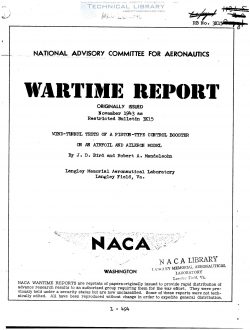naca-wr-l-494
- Version
- 136 Downloads
- 683.65 KB File Size
- 1 File Count
- April 2, 2017 Create Date
- April 2, 2017 Last Updated
Wind Tunnel Tests of a Piston Type Control Booster on an Airfoil and Aileron Model

By J, D, Bird and Robert A. Mendelsohn
SUKHARY
Measurements of control mements were made in the
NAGA stability tunnel to determine the operational char—
acteristics of a piston—type control booster on an aile—
ron. The tests were made on a 6—foot—span and 4—foot‘
chord airfoil which extended completely across the 6—foot—
square test section. The chord of the aileron was 31 per—
cent of the airfoil chord and the aileron span was one-
half that of the airfoil.
The booster was so constructed and installed that
pressures picked up from the air stream below the wing
acted on a pair of pistons. The resulting force Was
transmitted from the pistons to the aileron by a system
of linkages and gears in such a way that the moment pro—
duced by the booster increased almost linearly with aile—
ron deflection in Opposition to the hinge moment of the
aileron.
The data are presented in the form of curves of pres—
sure coefficients acting on the pistons, hinge—moment coef—
ficients, and booster coafficients plotted against aileron
deflection. The results of the investigation indicate that
fairly good balance of aileron hinge moments should be ob—
tained by the use of this type of booster.
INTRODUCTIOH
With the advent of the high—speed airplane and the
increased demand for higher rolling velocities, some means
must be provided to keep stick forces within the limit of
the pilot's strength. Several devices for attaining this
condition are in present use, such as Fries ailerons, horn
balances, internal balances, tabs, and beveled aileron
trailing edges, but most of these devices have various
difficulties which limit their use.
A new device, the piston—type control booster, has
been suggested as a method for obtaining aileron hinge—
moment balance. This device utilizes the force produced
by the action of air pressure on a-pair of pistons. The
pressure is to be obtained from a pair of ports, one fac—
ing forward and the other rearward, which are suitably
located in the air stream. If the pistons are connected
to the aileron with a system of linkages and gears, the
booster can be made to supply a counteracting moment that
varies with'aileron deflection in almost any desired manner:
for the'present series of tests a booster linkage'producing
practically a straight line variation of moment with aileron
deflection was chosen. This system would'make feasible the
use of plain sealed ailerons with the consequent low drag,
simplicity of construction, and high aerodynamic efficiency.
Because the'aileron—balance area forward of the hinge would
be unnecessary, the loads on the hinges and aileron struc—
ture would be less.and thus allow the use of lighter con—
struction than is required with most conventional balances.
The=pist6n~type balance apparentlyfcould'be'mOre easily
manufactured to give a given hinge—moment'eoefficient than
the-conventional aerodynamic balances, and'the-adflustments
reguired'to obtain and maintain a close balance of binge
moments on each aileron could be somewhat-reduced,
The present investigation was made to determine the
characteristics of a piston—type control booster that was
designed-to be approximately the correct size for balancing
one aileron on.a.large modern pursuit airplane.' Tests were
made at two angles of attack'and two airspeeds for the confi
ditions of the aileron.with booster, the aileron alone, and
the.booster alone. The data are presented in the form of
curves of pressure coefficients acting on'the'pistons,
booster—moment coefficients, and hinge-moment coefficients
plotted against aileron deflection.
| File | Action |
|---|---|
| naca-wr-l-494 Wind Tunnel Tests of a Piston Type Control Booster on an Airfoil and Aileron Model.pdf | Download |

Comment On This Post